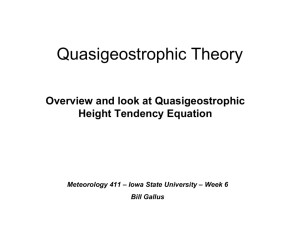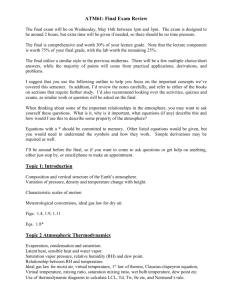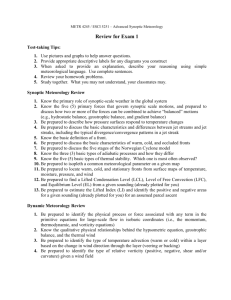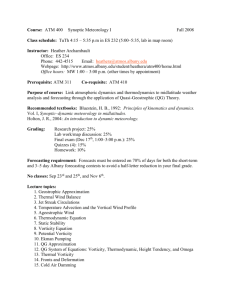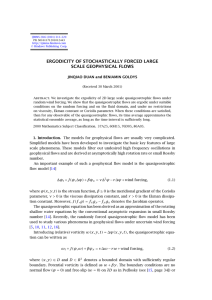The Thermodynamic Energy Equation is
advertisement
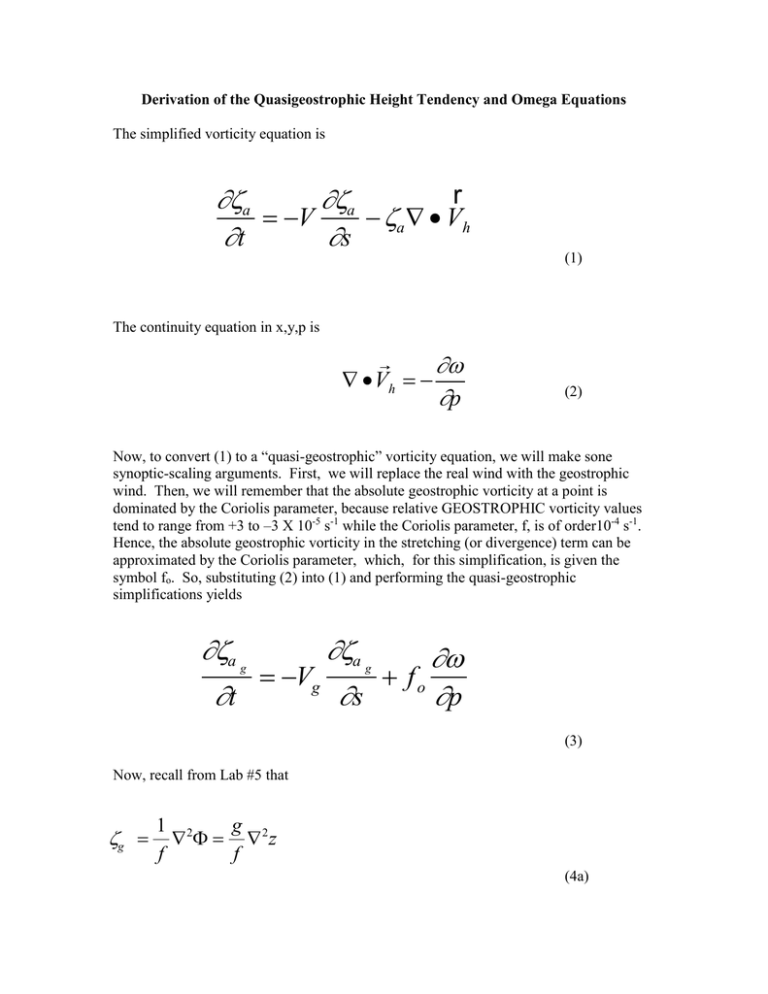
Derivation of the Quasigeostrophic Height Tendency and Omega Equations The simplified vorticity equation is r a a V a Vh t s (1) The continuity equation in x,y,p is Vh p (2) Now, to convert (1) to a “quasi-geostrophic” vorticity equation, we will make sone synoptic-scaling arguments. First, we will replace the real wind with the geostrophic wind. Then, we will remember that the absolute geostrophic vorticity at a point is dominated by the Coriolis parameter, because relative GEOSTROPHIC vorticity values tend to range from +3 to –3 X 10-5 s-1 while the Coriolis parameter, f, is of order10-4 s-1. Hence, the absolute geostrophic vorticity in the stretching (or divergence) term can be approximated by the Coriolis parameter, which, for this simplification, is given the symbol fo. So, substituting (2) into (1) and performing the quasi-geostrophic simplifications yields a a Vg fo t s p g g (3) Now, recall from Lab #5 that g 1 2 g 2z f f (4a) a g 1 2 g f 2z f f f (4b) where ø =-gz. Substituting (4) into the left side of (3), remembering that the local tendency of f = 0 and expanding the absolute vorticity in the advection term, yields 2 2 V g ( g f ) f o t p (5) Quasigeostrophic Vorticity Equation where the vector notation is used for the horizontal advection term. This is the quasigeostrophic vorticity equation. It is valid to the extent that the wind is geostrophic and that the simplifications made to the vorticity equation based upon synoptic scaling apply. The thermodynamic energy equation is T T dQ T v T u t x y c pT dt p t u T x v T p 1 dQ y cp dt R (6a,b) We can substitute the equation of state into the hydrostatic law T p R p (7) and place (7) into (6). Equation (7) states that the temperature is proportional to the mean thickness of the layer centering on the level in quesiton. We can also assume that diabatic effects are small, substitute in the definition of the static stability parameter, and assume that hat the wind is geostrophic to obtain the quasigeostrophic thermodynamic energy equation,. p V g T p R t R p 2 (8) Quasigeostrophic thermodynamic energy equation We can simplify the left hand side of (8) by remembering that t t p p t (9a,b) where X is the geopotential height tendency (X<0 = height falls etc.). Equations (9a,b) can be substituted into equations (5) and (8) to obtain the final form of the quasigeostrophic vorticity and thermodynamic energy equations. (Equations 5.6.5 and 5.6.6 on page 328 of Bluestein). 2 f o V g (g f ) f o 2 p (10) p R p Vg T p R (11) Multiply (11) by -(fo2) R/p and differentiate with respect to pressure, f o2 2 f o2 2 Vg T f o 2 p p p (12) Now add (12) to (10) and rearrange terms to obtain the quasigeostrophic height tendency equation. 3 2 f 2 2 f o 2 R o V T 2 f o V g ( g f o ) g p (12) p p Quasigeostrophic Height Tendency Equation Please note that in many derivations, equation (7) is substituted into the temperature advection term. In that case, the temperature advection is appxoximated by the thickness advection by the geosgrophic wind. Multiply Equation (11) by (R/p) and then take the Laplacian of the result. Multiply Equation (10) by by -(fo) and differentiate the result with respect to pressure (∂/∂p). Subtracting (10) from (11) and collecting terms yields the quasigeostrophic omega equation. 2 f 2 2 f o2 o V g ( g f ) R p 2 V g T 2 p p (13) Quasigeostrophic Omega Equation Equations (12) and (13) can be rederived neglecting the assumption that diabatic effects are minimal. As Bluestein points out on pp. 328-330 this assumption is a bad one near the surface where diurnal sensible heating/cooling effects can be large, at cloud top level when radiational effects might be large, and, when latent heat releases associated with cloud development. 2 2 f 2 2 f o 2 R f o R 1 dQ o 2 f o V g ( g f ) p Vg T p dt p p p c p (14) Quasigeostrophic Height Tendency Equation With Diabatic Term 2 f 2 2 f o2 o V g ( g f ) R p 2 Vg T R p 2 1c dQ dt 2 p p p (15) Quasigeostrophic Omega Equation With Diabatic Term 4 Interpretation of the Quasigeostrophic Equations The left hand side of the two equations contains a term that has the appearance of a threedimensional Laplacian. The term can be estimated analytically, for example, when the user of the equation is attempting to evaluate the equations, say, for a 500 mb pattern with troughs and ridges. The pattern of omega is also sinusoidal. The exact evaluation will be left to Metr 520 (Dymamic Meteorology II), and reduces to a constant 2 f 2 2 2 2 1 f 2 o o C 2 k l p p where k and l are constants dependent upon wavelength and amplitude of the disturbance at a given pressure level p. Applying (15) to the left hand sides of equations (13) and (14) allows one to make the assumption that f o V g ( g f ) | (16) 2 f o 2 R f o R 1 dQ V T p g p dt p p c p “Dynamic Effects” “Thermal Effects” | (17) Simplified Quasigeostrophic Height Tendency Equation With Diabatic Term and f o2 V g ( g f ) R 2 Vg T R 2 1 dQ p p c p dt p | “Dynamic Effects” “Thermal Effects” | (18) Simplified Quasigeostrophic Omega Equation With Diabatic Term The tendency equation (prognostic) states that height falls at a given location on a pressure surface (say, 500 mb) when, at that location, positive (or cyclonic) vorticity advection occurs, and/or cold advection decreasing with height (known as differential temperature advection), and/or sensible chilling decreasing with height (differential diabatic temperature change). 5 The omega equation (diagnostic) states that upward motion at a given location on a pressure surface (say, 500 mb) is associated with vorticity advection becoming more cyclonic with height (known as differential vorticity advection), and/or a warm advection maximum is located at that point, and/or a sensible heating maximum is located at that point. 6
